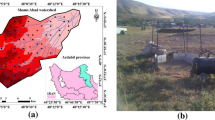Abstract
The present study investigates experimentally the effect of watershed (i.e. field plot of 22 m × 5 m) slope on rainfall-generated runoff and, in turn, the runoff curve numbers (CN) resulting from field plots (with land use of maize and sugarcane on the soil falling in Hydrologic Soil Group C) located in Roorkee, (India). The results indicated that the plot of 5 % slope yielded the largest runoff and, in turn, CN compared to those due to the plots of 3 and 1 % grades, for the same rainfall, soil, and land use. The CN derived from the present study were quite close to the NEH-4 CN-values, indicating satisfactory match between the two. The use of slope adjusted CN-values in the standard CN method significantly (at 5 % level) improved the otherwise underestimated large runoff events, i.e. model efficiency E improved from 0.47 to 0.78, and R2 from 0.71 to 0.83.






Similar content being viewed by others
References
Barros AP, Knapton D, Wang MC, Kuo CY (1999) Runoff in shallow soils under laboratory conditions. J Hydrol Eng 4(1):28–37
Bhuyan SJ, Mankin KR, Koelliker JK (2003) Watershed-scale AMC selection for hydrologic modeling. Trans ASAE 46:237–244
Chaplot VAM, Bissonnais YL (2003) Runoff features for interrill erosion at different rainfall intensities, slope lengths, and gradients in an agricultural loessial hillslope. Soil Sci Soc Am J 67:844–851
Dodds WK (1997) Distribution of runoff and rivers related to vegetative characteristics, latitude, and slope: a global perspective. J N Am Benthol Soc 16:162–168
Ebrahimian M, Nurruddin AAB, Soom MAB, Sood AB, Neng LG (2012) Runoff estimation in steep slope watershed with standard and slope adjusted curve number methods. Pol J Environ Stud 21(5):1191–1202
El-Hassanin AS, Labib TM, Gaber EI (1993) Effect of vegetation cover and land slope on runoff and soil losses from the watersheds of Burundi. Agric Ecosyst Environ 43:301–308
Gajbhiye S, Mishra SK (2012) Application of NRSC-SCS curve number model in runoff estimation using RS & GIS. International Conference on Advances in Engineering, Science and Management (ICAESM). 30–31 March 2012. pp 346–352
Garg V, Nikarn BR, Thakur PK, Aggarwal SP (2013) Assessment of the effect of slope on runoff potential of a watershed using NRCS-CN method. Int J Hydrol Sci Technol 3(2):141–159
Haggard BE, Moore PA, Delaune PB, Smith DR, Formica S, Kleinman PJ, Daniel TC (2002) Effect of slope, grazing and aeration on pasture hydrology. In ASAE Annual International Meeting/CIGR XVth World Congress, Hyatt Regency, Chicago, IL, USA
Hawkins, RH (1973) Improved prediction of storm runoff in mountain watersheds. J Irrig Drain Div ASCE 99:519–523
Hawkins RH (1993) Asymptotic determination of runoff curve numbers from data. J Irrig Drain Eng 119(2):334–345
Huang J, Zhao X, Wu P (2013) Surface runoff volumes from vegetated slopes during simulated rainfall events. J Soil Water Conserv 68(4):283–295
Huang M, Jacgues G, Wang Z, Monique G (2006) A modification to the soil conservation service curve number method for steep slopes in the Loess plateau of China. Hydrol Process 20(3):579–589
King KW, Arnold JG, Bingner RL (1999) Comparison of Green–Ampt and curve number methods on Goodwin Creek watershed using SWAT. Trans ASAE 42:919–925
Knisel WG (1980) CREAMS: a field-scale model for chemical, runoff and erosion from agricultural management systems. Conservation Research Report No. 26, South East Area, US Department of Agriculture, Washington, DC
Nash JE, Sutcliffe JE (1970) Modeling infiltration during steady rain. Water Resour Res 9:384–394
Ponce VM, Hawkins RH (1996) Runoff curve number: has it reached maturity? J Hydrol Eng ASCE 1:11–19
SCS (1956, 1964, 1972) ‘Hydrology’ National Engineering Handbook, Supplement A, Section 4, Soil Conservation Service, USDA, Washington, D.C
Shafiq M, Ahmad B (2001) Surface runoff as affected by surface gradient and grass cover. J Eng Appl Sci (Pak) 20:88–92
Sharpley AN, Williams JR (1990) EPIC-erosion/productivity impact calculator: 1. Model determination. US Department of Agriculture. Tech. Bull., No. 1768
Van Mullen JA (1991) Runoff and peak discharges using Green–Ampt infiltration model. J Hydraul Eng ASCE 117:354–370
Young RA, Onstadt CA, Bosch DD, Anderson WP (1989) AGNPS: a nonpoint-source pollution model for evaluating agricultural watersheds. J Soil Water Conserv 44(2):168–173
Acknowledgments
The authors are grateful to the Indian National Committee on Surface Water (INCSW) (formerly Indian National Committee on Hydrology (INCOH)), Ministry of Water resources, Govt. of India, New Delhi, for sponsoring this research.
Author information
Authors and Affiliations
Corresponding author
Rights and permissions
About this article
Cite this article
Mishra, S.K., Chaudhary, A., Shrestha, R.K. et al. Experimental Verification of the Effect of Slope and Land Use on SCS Runoff Curve Number. Water Resour Manage 28, 3407–3416 (2014). https://doi.org/10.1007/s11269-014-0582-6
Received:
Accepted:
Published:
Issue Date:
DOI: https://doi.org/10.1007/s11269-014-0582-6




